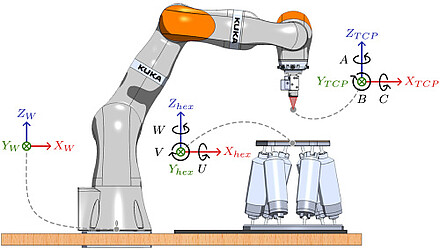Since the foundation of the research group around Robert Huber in 2007, numerous milestones have been set in research around FDML lasers, OCT imaging or nonlinear optics. Among them are not only research-related events but also technological leaps that should be mentioned here.
First use of the Neuro-OCT system in the operating room for in-vivo imaging during brain tumor resection surgery
2024
First publication on the LARA-OCT project for large-area OCT imaging
2024
We demonstrate large-area robotically assisted optical coherence tomography (LARA-OCT), utilizing a seven-degree-of-freedom robotic arm in conjunction with a 3.3 MHz swept-source OCT to raster scan samples of arbitrary shape. We implemented a real time probe-to-surface control that maintains the probe alignment orthogonal to the sample by only using surface information from the OCT images. We present OCT data sets with volume sizes of 140 × 170 × 20 mm3, captured in 2.5 minutes.

OCT video of human retina
2015
The video displays an OCT recording of a human retina. It was recorded at a volume rate of 20.8 V/s and consists of 255x255x450 voxels. Intentional movements of up to 100°/s are resolved.
High definition live 4D-OCT in vivo: Triops
2014
The video was acquired and processed in real time. The OCT system uses a 1310 nm Fourier domain mode locked (FDML) laser operated at 3.2 MHz sweep rate. The acquired data was processed and visualized on a GPU [10.1364/BOE.5.002963].
High definition live 4D-OCT in vivo for surgical guidance
2014
The video was acquired and processed in real time. The OCT system uses a 1310 nm Fourier domain mode locked (FDML) laser operated at 3.2 MHz sweep rate and the data was processed and visualized on a GPU [10.1364/BOE.5.002963].
3D reconstruction of intravascular OCT scan with 3200 fps
2013
A micromotor driven catheter developed in the group of Dr. Gijs van Soest in combination with our 1.6 MHz FDML-OCT surpasses the acquisition speed of state of the art intravascular OCT by more than one order of magnitude [10.1364/OL.38.001715].
Anterior segment imaging with extended coherence length MHz FDML laser
2012
OCT imaging at 60 nm sweep range and 1.6 MHz scan rate. The 3D reconstruction of the whole anterior segment consisting of 1000 x 985 x 560 voxels (frames x depth scans x samples/scan) was acquired in a total time of 0.8 seconds [10.1364/BOE.3.002647].
Anterior segment imaging with extended coherence length MHz FDML laser
2012
The 3D reconstruction of the whole anterior segment consisting of 1000 x 900 x 560 voxels (frames x depth scans x samples/scan) was acquired in a total time of 0.8 seconds [10.1364/BOE.3.002647].
High quality 3D imaging at 20 million A-scans and 4.5 GVoxels per second
2010
This three dimensional dataset was acquired in 25ms. This was accomplished by using a FDML laser with a sweep rate of 5.2 MHz per spot and a 4-spot illumination [10.1364/OE.18.014685].











